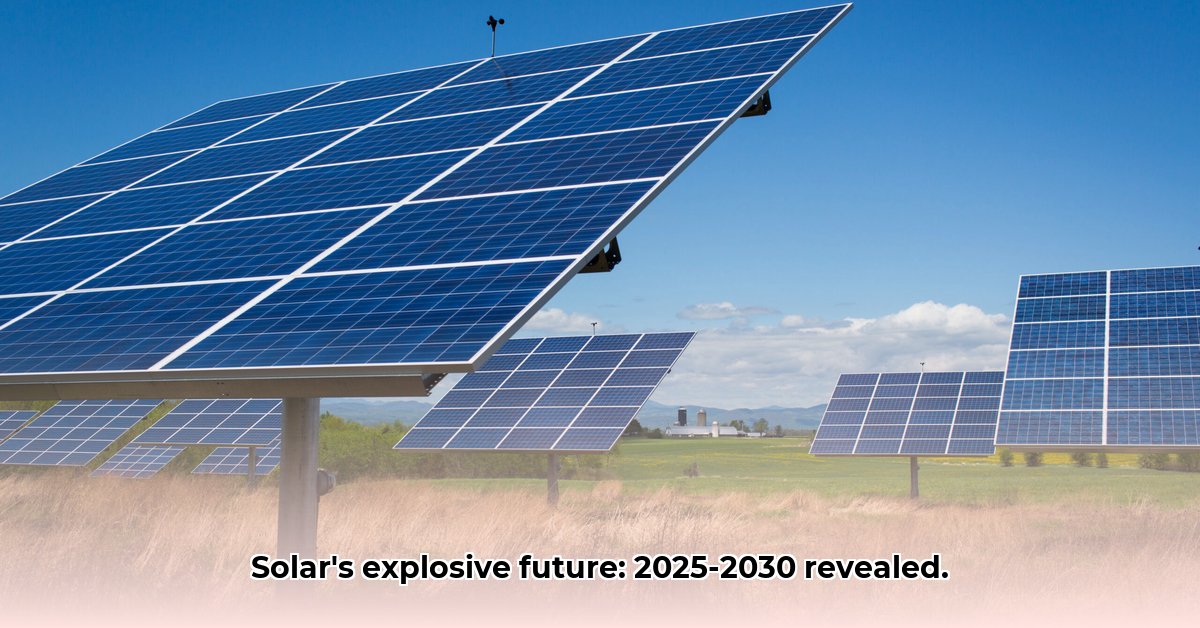Get ready for a solar revolution! The next five years are going to be huge for solar energy. This article breaks down what’s happening, answering the big questions for everyone from investors to businesses and even city planners. We’ll show you how to avoid common solar investment traps and give you smart strategies to make your solar panels work better. You’ll learn the differences between different solar technologies and how to ensure your system is ready for the future. We’ll also look at how government rules are changing things and who’s leading the charge in solar innovation. Understanding how technology, markets, and government work together is key to making the most of solar power and building a cleaner energy future. Let’s dive in! For more on solar types, see this helpful guide.
Solar Energy and the Future: Key Innovations in 2025-2030
The sun’s energy is poised to play a much bigger role in our lives over the next five to ten years. But what exactly does the future hold for solar power? Let’s dive into the exciting technological advancements and market shifts shaping this clean energy revolution.
Technological Leaps: Solar Power’s Efficiency Revolution
The next few years will be a game-changer for solar technology. One of the biggest areas of focus is boosting the efficiency of solar panels. Think of it like this: a more efficient panel generates more electricity from the same amount of sunlight, making solar power cheaper and more appealing. We’re talking about squeezing more juice from the same lemon!
Perovskite solar cells are a particularly hot topic. These newcomers are potentially much cheaper to produce than traditional silicon cells, and they could be just as effective at converting sunlight into electricity. If they live up to their potential, they’ll really shake things up in the solar industry. Researchers are exploring various compositions and structures to enhance their stability and longevity, bringing them closer to commercial viability.
Concentrated solar power (CSP) is another technology with huge potential. CSP systems use mirrors to focus sunlight onto a single point, generating intense heat to power turbines. It’s like a giant magnifying glass powering a power plant! Innovations in CSP include advanced thermal storage materials, enabling these plants to generate electricity even when the sun isn’t shining. This makes CSP a more reliable and dispatchable energy source.
The challenge with both solar panel and CSP technologies is that the sun doesn’t shine all the time. That’s why improving energy storage is just as crucial. Better batteries and thermal storage solutions are key to ensuring a steady supply of solar electricity, day and night. Imagine a world where homes and businesses run smoothly on solar power, regardless of the time of day. Advancements in battery technology like lithium-ion and solid-state batteries are being actively developed. Companies such as Tesla and LG Chem are pushing the boundaries of lithium-ion technology, while solid-state batteries, promising higher energy density and improved safety, are attracting significant investment from firms like Toyota and QuantumScape.
Market Forces: Sunshine and Renewable Energy Investments
The growth of the solar energy market isn’t just about clever technology; it’s also heavily influenced by economics and government policies. Government support, in the form of tax breaks, subsidies, or regulations that encourage solar energy adoption, is crucial. The amount of investment the government puts into solar will likely determine how fast the industry grows. The Inflation Reduction Act (IRA) in the United States, for example, provides substantial incentives for solar energy development, driving significant investment and job creation in the sector.
Venture capitalists and other investors are also playing a big role. They decide where to put their money, choosing between established technologies or newer, riskier projects. Their decisions will directly influence which solar technologies become mainstream. The potential to provide affordable electricity to developing countries is a particularly exciting market. It presents a massive opportunity for businesses and investors willing to take on the challenge of expanding access to clean energy in those areas. Microgrids powered by solar energy are gaining traction in remote and underserved communities, offering a reliable and cost-effective alternative to traditional grid infrastructure. Market incentives like feed-in tariffs, net metering policies, and tax credits are proving effective in driving investments in solar energy projects worldwide. Germany’s feed-in tariff program, for instance, has been instrumental in fostering the growth of its solar industry.
Actionable Advice: Strategic Steps for Stakeholders in Clean Energy
Here’s what different groups can do to shape the future of solar power:
Solar Companies: Invest heavily in research and development (R&D). Work on more efficient and affordable ways to produce solar panels and explore new markets. Getting your supply chain working smoothly is also vital. Supply chain diversification is becoming increasingly important to mitigate risks associated with reliance on specific regions or suppliers.
Governments: Put clear policies in place to support renewable energy growth. Invest in improving the grid system to handle the influx of solar electricity. International cooperation is essential to tackling this global challenge collaboratively. Standardized regulations and streamlined permitting processes can significantly reduce project development timelines and costs.
Investors: Carefully analyze the potential risks and rewards before investing in a particular solar company or technology. Diversifying your investments is a smart strategy, especially considering the rapid pace of innovation in this field. Environmental, Social, and Governance (ESG) factors are playing an increasingly prominent role in investment decisions, with investors seeking companies that demonstrate a strong commitment to sustainability and responsible business practices.
Consumers: Think about installing solar panels on your home. Support policies that promote sustainable energy and let your elected officials know that you care about clean energy. Community solar programs offer an opportunity for individuals who may not be able to install solar panels on their own homes to still benefit from solar energy.
Looking Ahead: Future Solar Energy Forecasting
Predicting the future of solar energy is tricky. While both solar panels and CSP are likely to remain key players for decades, several factors are bound to influence growth. These include government support, the pace of technological advancements, and changes in consumer preferences. Factors like the rising adoption of electric vehicles (EVs) impacting residential energy usage, create new demand profiles that solar can help meet.
It’s safe to say that solar energy adoption is likely to accelerate in the next five years. However, the exact path it takes will depend on a complex mix of innovation, market trends, and policy decisions. Integration with smart grid technologies and advanced data analytics will enhance the efficiency and reliability of solar energy systems.
Navigating the Risks: Evaluating Solar Technologies
Here’s a quick look at some of the risks and how to mitigate them:
| Technology | Key Risks | Ways to Reduce Risk |
|---|---|---|
| Silicon PV | Reliance on specific materials; manufacturing costs. | Secure diverse sources of raw materials; optimize manufacturing. |
| Perovskite PV | Technology still developing; scaling up production is challenging. | Increase R&D investment; conduct larger-scale pilot projects. |
| Concentrated CSP | High upfront costs; water usage. | Design improvements; explore water-efficient technologies. |
| Energy Storage | Battery cost and lifespan; environmental impact of battery production | Advancements in battery technology; develop effective recycling programs. |
| Grid Integration | Inadequate infrastructure; regulatory hurdles. | Invest in grid modernization; streamline permitting processes. |
This table highlights some of the challenges and opportunities facing various solar technologies. Managing these risks is critical to unlocking the full potential of solar energy and ensuring a sustainable energy future for all. Ongoing research and development in areas like more efficient solar cells, advanced energy storage solutions, and improved grid integration will play a crucial role in shaping solar energy’s future. Considering these risks and mitigation strategies, solar could realistically meet 30-40% of global energy demand by 2030, according to projections from the International Renewable Energy Agency (IRENA). It’s an exciting time to be part of this journey!
How to Mitigate Risks in Perovskite Solar Cell Investments
Key Takeaways:
- Perovskite solar cells (PSCs) offer dramatically higher energy conversion than traditional silicon, but their use of lead creates significant environmental and health concerns.
- How to mitigate risks in perovskite solar cell investments requires a multi-pronged approach addressing manufacturing, usage, and disposal.
- Lead-free alternatives are developing, but currently lack the efficiency and stability of lead-based PSCs.
The Promise and Peril of Perovskites: Energy Conversion and Environmental Factors
The renewable energy sector is buzzing about perovskite solar cells. They boast impressive energy conversion efficiencies—far surpassing traditional silicon-based cells. This efficiency translates to potentially lower manufacturing costs and a smaller land footprint for large-scale solar farms. But this exciting technology comes with a cautionary note: lead. Many high-efficiency perovskite formulations rely heavily on lead, a highly toxic substance. This poses significant risks throughout the cell’s lifecycle. These risks include potential contamination of soil and water during manufacturing, accidental release during usage, and improper disposal at the end of the cell’s life.
Navigating the Challenges: A Multi-Faceted Approach for Solar Cell Investment
So, how to mitigate risks in perovskite solar cell investments? It’s not about avoiding perovskite technology altogether, but about intelligently managing the risks. This requires a focus on several key areas:
- Manufacturing Safety: Manufacturing processes need improvement. Safer solvents should replace hazardous ones. Enhancing worker safety through strict protocols and protective equipment is paramount. Investing in robust ventilation systems is also essential. Closed-loop manufacturing systems that recycle solvents and minimize waste can further reduce environmental impact.
- Robust Encapsulation: Preventing lead leaching is crucial. This involves further developing and standardizing advanced encapsulation methods. These methods aim to create a nearly impenetrable barrier around the perovskite layer, shielding it from the elements and preventing lead from escaping. Think of it as a high-tech protective suit for the solar cell. Research is exploring materials like glass, polymers, and thin-film coatings for encapsulation.
- Exploring Lead Sequestration: This technique involves trapping lead within the cell’s structure, preventing its release. This is still under development, but successful methods are vital. Imagine it like building a “lead cage” within the cell. Chemical binding agents and physical barriers are being investigated for lead sequestration.
- Lead-Free Alternatives: The holy grail of perovskite research is to develop high-efficiency cells without lead. Significant progress is needed, but the long-term viability of PSCs hinges on finding safe alternatives. Tin, bismuth, and antimony are being explored as potential replacements for lead in perovskite structures.
- End-of-Life Management: What happens to PSCs at the end of their lives? Developing robust recycling infrastructures is vital. This requires collaboration between manufacturers, governments, and consumers to create sustainable disposal options. Recycling will be key to the long-term success of perovskite solar technology. Innovative recycling processes are being developed to recover valuable materials from end-of-life PSCs, including lead (if present), perovskite materials, and electrode components.
- Regulatory Compliance: Governments and regulatory bodies must define clear standards for PSC manufacturing, usage, and disposal. This includes stringent safety regulations and lifecycle assessment frameworks. Investors must ensure all processes comply with these evolving regulations. The European Union’s Restriction of Hazardous Substances (RoHS) directive may influence the development and usage of lead-free perovskites.
The Investor’s Perspective: Due Diligence Critical For Solar Cell Investments
For investors, understanding and managing these risks is essential. Thorough due diligence is not just recommended; it’s mandatory. Analyze the manufacturing process of any company utilizing perovskite technology. Assess their commitment to environmental sustainability and safety protocols. Look for evidence of lead-leaching testing and recycling plans. Independent third-party certifications can provide an objective assessment of a company’s environmental performance.
The Future is Bright, but Careful Navigation is Needed with Solar Energy
Perovskite solar cells hold incredible potential. They offer a significant upgrade over current solar technologies. But ignoring the environmental risks would be irresponsible. Investing in this technology means actively participating in shaping a responsible future for renewable energy. This requires a commitment to research, development, and responsible manufacturing practices. With a focus on responsible innovation, investors should use metrics such as lead-leaching rates, energy payback time, and recycling efficiency to evaluate the environmental impact of perovskite solar cell manufacturing. A study published in Nature Sustainability highlights the importance of lifecycle assessment in evaluating the environmental impact of perovskite solar cells. The future of perovskite solar energy is bright, but only if navigated cautiously.
Solar Energy Policy Impacts on Rural Electrification
Key Takeaways:
- The rapid expansion of solar energy in rural areas presents both significant opportunities and challenges for sustainable agriculture.
- While offering substantial economic benefits to landowners, concerns exist regarding land-use conflicts, potential soil degradation, and impacts on agricultural productivity.
- Successful integration demands careful consideration of agrivoltaic techniques, strong regulations, and strategic policy interventions.
Navigating the Complexities of Rural Solar Energy Development
The rise of solar energy offers a powerful solution for electrifying rural communities, a move that could drastically improve quality of life and boost economic development. However, the path isn’t straightforward. Solar Energy Policy Impacts on Rural Electrification are multifaceted, impacting farmers, developers, and policymakers alike. Specifically looking at policies related to grid interconnection, land use zoning, and financial incentives.
The Promise and Peril of Solar Leasing and Land Use
For landowners, solar energy presents a lucrative source of income through leasing agreements with solar developers. These agreements can generate significant revenue, particularly for those with large tracts of land. But, it’s not all sunshine and roses. Concerns exist about long-term land-use impacts and the potential displacement of agricultural activities. What happens when lease agreements expire? How do we ensure sustainable land management practices are followed? These are vital questions. Lease agreements should include clauses that address land restoration and remediation at the end of the project’s lifespan.
Agrivoltaics: A Path Towards Coexistence and Sustainable Farming?
One potential solution lies in agrivoltaics—the practice of integrating solar panels into agricultural landscapes. This approach aims to mitigate land-use conflicts by allowing both solar energy generation and crop production to occur simultaneously. While promising, the long-term effectiveness and scalability of agrivoltaics remain subjects of ongoing research and debate. Researchers at the University of Massachusetts Amherst are conducting studies to evaluate the impacts of agrivoltaic systems on crop yields and soil health. Given the long term cost savings, policymakers should explore agrivoltaics and offer incentives for farmers to adopt this practice. Examples include tax credits, grants, and technical assistance programs. We need more data and evidence based on a broad range of climates, soil types, and crops.
Policy’s Crucial Role For Effective Rural Electrification
Effective policies are essential for navigating the complexities of rural solar development. These policies must incentivize responsible land use and environmental stewardship while facilitating grid access and addressing financial hurdles for rural communities. Regulations should encourage agrivoltaic practices, provide clear guidelines for site selection and decommissioning, and ensure minimal disruption to agricultural activities. Without such policies, we risk unintended environmental and economic consequences. Streamlined permitting processes, standardized interconnection agreements, and community benefit agreements can reduce project development costs and foster local support.
Addressing the Challenges For Green Energy
Several key challenges must be addressed to ensure the successful integration of solar energy in rural areas. These include:
- Land-use conflicts: Balancing the need for solar energy with the preservation of productive agricultural land.
- Soil degradation: Minimizing the environmental impact of solar farm construction and decommissioning on soil health.
- Economic impacts: Ensuring that rural communities benefit equitably from solar energy development while preventing land values from skyrocketing and displacing farmers.
- Grid integration: Addressing delays in grid connections, often a major bottleneck for rural solar projects. Modernizing rural electric grids to accommodate distributed solar generation and energy storage is crucial.
Looking Ahead To Future of Renewable Resources
The future of rural electrification relies heavily on effectively managing the interplay between solar energy development and agriculture. Strategic policy interventions, innovative technological solutions like agrivoltaics, and robust community engagement are all vital ingredients for realizing the environmental and economic benefits of solar energy while protecting the livelihoods of rural communities and the environment. Regulatory frameworks that incorporate community input, prioritize agrivoltaic practices, and offer financial incentives for sustainable land management can minimize land-use conflicts between solar energy development and agriculture in rural areas. The National Renewable Energy Laboratory (NREL) provides resources and guidance on best practices for rural solar development.
Global Solar Energy Market Segmentation by Technology and Region
Key Takeaways:
- The global solar energy market is booming, fueled by falling costs, supportive government policies, and growing clean energy demand.
- Asia-Pacific, especially China, dominates, but other regions offer significant growth potential, particularly the Middle East and Africa.
- While photovoltaic (PV) systems lead, innovations like bifacial modules and perovskite-silicon tandem cells promise even greater efficiency and cost reductions.
Technological Segmentation: Diverse Energy Source and Landscape
The Global Solar Energy Market Segmentation by Technology and Region isn’t a monolithic entity. It’s a vibrant mix of technologies, each with its own strengths and weaknesses. Photovoltaic (PV) systems currently dominate, converting sunlight directly into electricity. Within PV, we see further segmentation:
- Crystalline Silicon: This mature technology makes up the bulk of the market, offering a balance of cost-effectiveness and reliability. Continuous improvements drive efficiency gains. Passivated Emitter and Rear Cell (PERC) technology and TOPCon (Tunnel Oxide Passivated Contact) are examples of advancements boosting performance.
- Thin-Film: These lightweight, flexible panels offer advantages in certain applications, such as building-integrated photovoltaics (BIPV). However, they generally lag crystalline silicon in efficiency. Cadmium telluride (CdTe) and copper indium gallium selenide (CIGS) are the most common thin-film technologies.
- Concentrated Solar Power (CSP): CSP systems use mirrors or lenses to concentrate sunlight onto a receiver, generating heat to drive turbines. This offers the advantage of energy storage through thermal storage systems, mitigating intermittency. However, CSP requires large land areas and high initial capital investment. Molten salt storage is a widely used thermal storage technology in CSP plants.
- Emerging Technologies: Perovskites and perovskite-silicon tandem cells are generating considerable excitement. Their potential to significantly boost efficiency could reshape the market in the coming years. But challenges remain in scalability and long-term stability. Researchers are exploring different perovskite compositions and device architectures to enhance their performance and durability.
Regional Segmentation: Shifting Market and Power Dynamic
The geographic distribution of solar energy adoption is equally dynamic. The Global Solar Energy Market Segmentation by Technology and Region reveals a clear picture of regional disparities:
- Asia-Pacific: This region, particularly China, is currently the undisputed leader, boasting massive manufacturing capacity and robust domestic demand. Government incentives and large-scale solar projects are driving growth in this region.
- North America: The US market is experiencing rapid growth, driven by the Inflation Reduction Act and increasing consumer adoption. Canada also shows strong potential. The IRA provides tax credits and other incentives for solar energy development in the United States.
- Europe: While facing challenges related to land availability and permitting processes, Europe is making significant strides in solar energy deployment, spurred by ambitious renewable energy targets. The European Union’s Green Deal aims to achieve climate neutrality by 2050, driving investments in renewable energy sources.
- Middle East & Africa: This region offers exceptional solar resource potential, but substantial investment in grid infrastructure and policy support is needed to unlock its full potential. Countries like Saudi Arabia and the United Arab Emirates are investing heavily in solar energy projects.
The regional landscape is in constant flux. Emerging economies are rapidly expanding their solar capacity, while mature markets are focusing on grid integration and technological advancements. Geopolitical factors and policy changes can significantly influence this dynamic. Supply chain disruptions and trade disputes can impact the availability and cost of solar panels.
Market Drivers and Challenges in the Solar Energy Industry
Several key factors are driving the growth of the Global Solar Energy Market Segmentation by Technology and Region:
- Falling Costs: The cost of solar PV modules has decreased dramatically over the past decade, making solar energy increasingly competitive with traditional energy sources.
- Government Support: Many countries are implementing supportive policies, such as subsidies, tax credits, and renewable energy mandates, to accelerate solar energy adoption.
- Environmental Concerns: Growing awareness of climate change and the need to transition to cleaner energy sources is fostering a strong demand for renewable energy solutions.
However, challenges persist:
- Supply Chain Vulnerabilities: The solar industry’s reliance on specific geographic regions for raw materials and manufacturing presents supply chain risks. Diversifying supply chains and promoting domestic manufacturing can mitigate these risks.
- Grid Integration: Integrating large-scale solar power into existing electricity grids requires significant upgrades and investments in grid infrastructure. Smart grid technologies and energy storage solutions are crucial for enabling seamless integration.
- Intermittency: Solar energy’s intermittent nature requires effective energy storage solutions to ensure grid stability and reliability. Battery storage, pumped hydro storage, and thermal storage are among the technologies being used to address intermittency.
Future Outlook: Complex Solar Energy Opportunities
The future of solar energy is bright, but it’s a complex picture. Technological advancements will continue to drive down costs and improve efficiency. Governments will need to implement comprehensive policies to address supply chain issues and facilitate grid integration. Energy storage solutions will play a vital role in enabling wider solar adoption. Given the dependence on China for raw materials, international cooperation can facilitate supply chain diversification in the solar industry through joint research and development initiatives, trade agreements, and investments in alternative manufacturing locations. The International Renewable Energy Agency (IRENA) promotes international cooperation and knowledge sharing in the field of renewable energy. The Global Solar Energy Market Segmentation by Technology and Region will continue to evolve, driven by a potent mix of technological innovation, government policies, and market forces. The race is on to harness the sun’s power effectively and sustainably. By reducing our dependence on older energy sources and embracing innovative solutions, we can accelerate the transition to a cleaner, more sustainable energy future for all.
- Choosing the Right Portable Hydro Turbine for Your Needs - December 14, 2025
- Best Portable Hydro Generators for Off-Grid and Outdoor Power - December 13, 2025
- Choosing the Right Generator with Water for Off-Grid Power - December 12, 2025
















